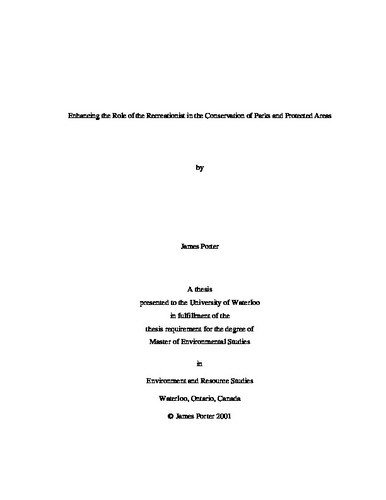| dc.contributor.author | Porter, James | en |
| dc.date.accessioned | 2006-08-22 14:08:02 (GMT) | |
| dc.date.available | 2006-08-22 14:08:02 (GMT) | |
| dc.date.issued | 2001 | en |
| dc.date.submitted | 2001 | en |
| dc.identifier.uri | http://hdl.handle.net/10012/981 | |
| dc.description.abstract | The tension between 'acceptable' human use of the environment and the management systems that intend to mitigate this use continues to be an important focus for discussion and research. This is particularly evident in the situation of recreation in parks and protected areas. Enhancing public participation in the development and implementation of resource management objectives has received much attention, in literature and in practice, as a way to mediate this tension. However, how this participation will come about or is to be facilitated necessitates further investigation. This thesis further develops the notion of public participation with a focus on recreationists as a valuable source of assistance for achieving the conservation agenda. It also highlights that the assistance that recreationists could potentially offer remains predominately untapped. Two reasons for this include the restrictiveness inherent in current recreation and environment management approaches, and underlying assumptions that discount the value of public participation or cater to an active public, or recreationist, minority. Drawing on relevant social research, this thesis attempts to better understand the individual recreationist and derive from this an understanding of possible opportunities through which recreationist participation in conservation could be enhanced. Complementing this discussion is an identification of park managers as key recipients of this research, and a redefinition of their role from manager to one that emphasizes aspects of leadership. Two methods were employed to further investigate this research: an extensive review of relevant theory as well as the use of two case studies: Killarney Provincial Park (Ontario, Canada) and Fish Creek Provincial Park (Alberta, Canada). Within each case study, interviews were conducted in the months of June and July 2000 with park staff and other appropriate individuals. At the same time, recreationists from both parks were surveyed. Interviews and survey questions were guided by the primary question of, how can the role of recreationists in the conservation of parks and protected areas be enhanced? Eleven recommendations emerged from this research in regard to: opportunities for recreationists to participate in conservation, the role of social research, and the relationship between park manager and recreationist. This paper concludes by establishing an argument advocating recreationist participation in conservation, and offers ways in which this participation could be achieved. | en |
| dc.format | application/pdf | en |
| dc.format.extent | 3189563 bytes | |
| dc.format.mimetype | application/pdf | |
| dc.language.iso | en | en |
| dc.publisher | University of Waterloo | en |
| dc.rights | Copyright: 2001,
Porter, James. All rights reserved. | en |
| dc.subject | Environmental Studies | en |
| dc.subject | recreationist | en |
| dc.subject | participation | en |
| dc.subject | motivation | en |
| dc.subject | constraint | en |
| dc.subject | leadership | en |
| dc.subject | park | en |
| dc.title | Enhancing the Role of the Recreationist in the Conservation of Parks and Protected Areas | en |
| dc.type | Master Thesis | en |
| dc.pending | false | en |
| uws-etd.degree.department | Environment and Resource Studies | en |
| uws-etd.degree | Master of Environmental Studies | en |
| uws.typeOfResource | Text | en |
| uws.peerReviewStatus | Unreviewed | en |
| uws.scholarLevel | Graduate | en |

